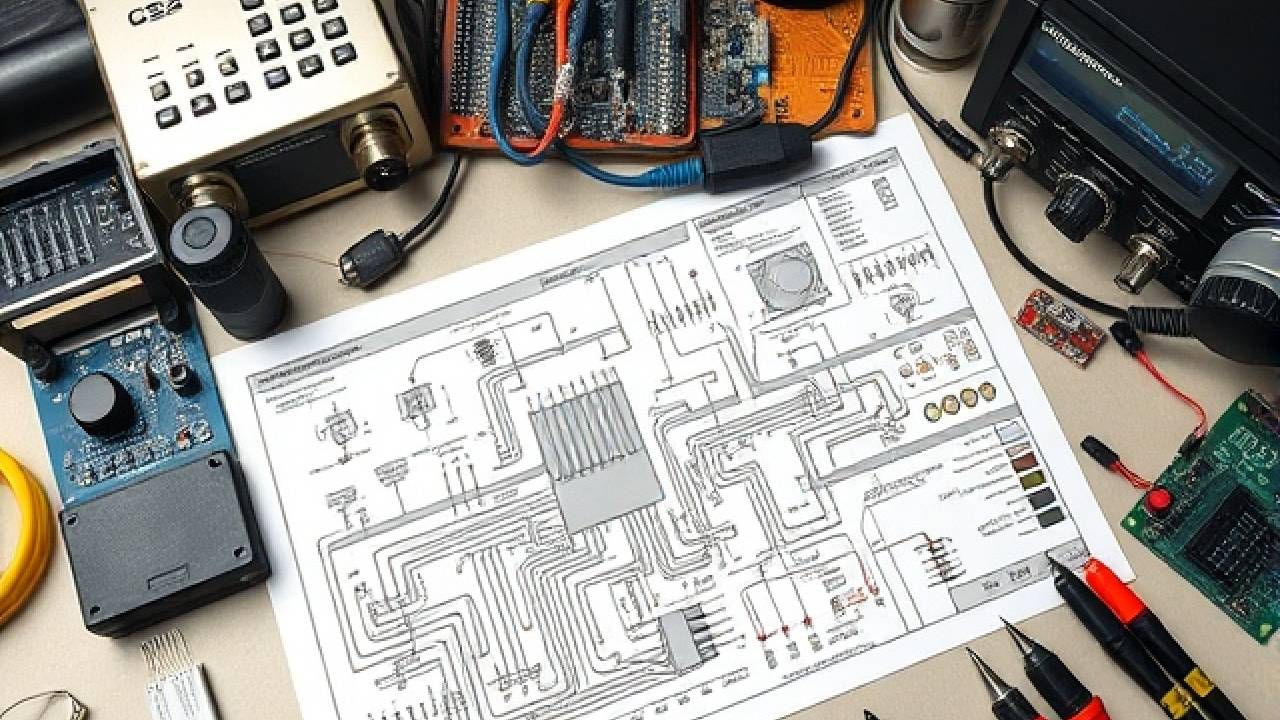In the intricate world of radio technology, the Pro Y Contras Del Radio Schematic CS227 presents a fascinating blend of possibilities and challenges. The schematic, renowned for its versatility, serves as a pivotal element in customizing communication pathways. However, with great adaptability comes a need for meticulous attention to detail, ensuring perfection at every juncture.
Historically, the Pro Y Contras Del Radio Schematic CS227 has been perceived as a cornerstone for modern radio advancements. It offers unparalleled frequency modulation capabilities, a factor driving its popularity among seasoned experts. On the flip side, the extensive complexity can often lead to extended troubleshooting times, a trade-off that sparks continuous debate within the field.
The Radio Schematic CS227 offers flexibility and cost-effectiveness, making it ideal for complex projects. However, its complexity can challenge beginners, requiring skilled troubleshooting and potentially costly additional components. Users benefit from its adaptability but must tackle issues like signal interference and part availability for optimal use.
Exploring the Pros of Radio Schematic CS227
The Pro Y Contras Del Radio Schematic CS227 stands out for its adaptability in various applications. Its design allows it to be modified easily to fit different tasks. This flexibility means users can employ it across multiple radio frequencies without hassle. Furthermore, this adaptability helps in enhancing communication signals. Thus, professionals often choose CS227 for complex projects requiring dynamic solutions.
An important benefit of CS227 is its cost-effectiveness. Its simple components make it affordable to produce and repair. Users save money, especially when compared to other, more intricate schematics. This makes CS227 a popular choice for budget-conscious projects. Moreover, availability of parts reduces repair time.
The CS227 also excels in reliability. Due to its straightforward design, it experiences fewer technical glitches. This reliability means less downtime and consistent operation. Users can trust it to perform under different conditions. Engineers value this stability, which is crucial during critical operations.
For professionals, the schematic’s ease of use is a major advantage. Even those new to radio technology can grasp its workings quickly. This user-friendliness reduces learning curves, encouraging more professionals to adopt it in their projects. As a result, teams can integrate CS227 seamlessly into existing systems. Overall, its simplicity and efficiency are key benefits.
Unrivaled Versatility of CS227
The CS227 schematic’s versatility is unmatched, making it a go-to choice for many. It caters to various needs, from simple communication tasks to complex networking systems. This capability to adapt enhances its appeal to both beginners and experts. Its design supports a range of frequencies, adding to its functionality. Users appreciate it for its wide applicability in diverse fields.
Flexibility in the CS227 is aided by the schematic’s adaptable components. These parts are interchangeable, allowing for easy modifications. Whether your project demands high frequency or low interference, CS227 adjusts accordingly. This interchangeability simplifies customizing setups for specific needs. Moreover, it reduces the need for multiple schematics.
Its versatility extends to educational settings too. Students and hobbyists find CS227 an excellent learning tool. It introduces concepts in a practical, hands-on manner. The schematic encourages creative problem solving and experimentation. In these environments, its ease of manipulation fosters inclusive learning.
In professional setups, CS227’s flexibility is beneficial for troubleshooting. Quick adaptations reduce downtime when changes are needed. This efficiency is essential in fast-paced industries. With CS227, there’s no need to pause proceedings for extensive adjustments. Professionals value this adaptive advantage to stay on schedule.
Unpacking the Cons of Radio Schematic CS227
One significant challenge of the CS227 is its complexity, especially for newcomers. Navigating its design can be misleading without proper guidance. This steep learning curve often deters beginners from utilizing its full potential. While its versatility is an asset, mastering its functions requires dedication. As a result, users might face initial frustrations.
Another downside is the vulnerability to signal interference. In environments with heavy electronic activity, maintaining signal clarity can be tough. Such interference impacts performance and necessitates additional components for stability. This need for extra parts can elevate the costs associated. Thus, users may face unexpected expenses during setup.
Maintenance can also be burdensome, given the intricate nature of the CS227. Technical glitches, although rare, require precise skills to resolve. This necessity for skilled labor can slow repairs and incur added costs. Users may need to hire specialists, increasing project budgets. Therefore, regular upkeep becomes a crucial consideration.
Finally, the availability of specific components can become an issue. Finding the right parts in local stores is sometimes difficult. This scarcity delays projects and adds to shipping expenses for online orders. Not having parts readily at hand can be frustrating for those on tight schedules. Many users plan ahead to avoid these setbacks.
The Necessity for Meticulous Detail in CS227 Usage
The Pro Y Contras Del Radio Schematic CS227 requires careful attention to detail during its setup and use. Each component must be correctly assembled to avoid malfunctions. Small mistakes can lead to significant issues, affecting overall performance. Therefore, users should ensure every connection is secure and properly configured. This thoroughness guarantees efficient operation.
Documentation plays a critical role in using Pro Y Contras Del Radio Schematic CS227 successfully. Keeping a record of setups, adjustments, and outcomes aids in troubleshooting. It helps identify what settings yield the best results without unnecessary repetition. A well-maintained log can be a helpful reference for future projects. Such proactive measures save time and resources.
Precision is crucial when adjusting the CS227’s frequency settings. Wrong adjustments lead to poor signal quality and interference. Users often rely on precise measurements and tools to achieve optimal settings. Regular calibration checks are necessary to maintain accuracy. This careful approach minimizes errors and enhances reliability.
List of common CS227 errors and troubleshooting tips can be helpful for users.
- Check all connections.
- Ensure proper power source.
- Review frequency settings regularly.
- Consult schematic guides when in doubt.
These steps streamline problem-solving, reducing downtime.
Using the right tools is vital to handle the CS227’s intricacies. Specialized equipment aids in achieving precision during installation. Without these, users might struggle with specific adjustments, leading to frustration. Investing in apt tools ensures smoother operations and ease of use. This foresight leads to more effective project execution.
The meticulous approach not only supports performance but also extends the lifespan of CS227 components. Regular maintenance avoids wear and tear that might otherwise be overlooked. A methodical inspection identifies potential issues early, ensuring longevity. By valuing this attention to detail, users protect their investments. Such care reflects on durability and sustained functionality.
Historical Significance of the CS227
The CS227 has played a crucial role in the evolution of radio technology. Its introduction marked a significant shift in how radio networks were designed. Innovators leveraged its capabilities to enhance communication systems. This impact is evident in various applications over the years. The CS227 established a foundation for future advancements in the field.
Throughout history, Pro Y Contras Del Radio Schematic CS227 has been integral in both civilian and military communications. Its adaptability allowed for use in diverse environments, from urban areas to remote regions. Engineers appreciated its reliability in challenging conditions. Consequently, it became a trusted choice for crucial communication tasks. These applications underscore its versatile nature and enduring relevance.
The CS227 has also contributed to educational advancements in electronics. It serves as a practical teaching tool, introducing students to essential radio concepts. Academic institutions utilize it to bridge theory and practice. This hands-on experience fosters deeper understanding and innovation. Thus, the CS227 continues to shape the next generation of radio technology professionals.
Impactful moments in history can be linked to CS227’s use:
- Expansion of global communication networks.
- Crucial in transmitting emergency broadcasts.
- Support in military operations for secure communication.
These examples illustrate the notable role CS227 has played in various sectors.
The CS227’s design inspired further innovations, influencing new radio technologies. Its foundational principles can be found in modern devices. Many newer schematics owe their existence to the path paved by CS227. This legacy continues to be acknowledged by contemporary engineers. Through its enduring significance, the CS227 holds a prominent place in radio history.
The Debate Surrounding CS227 Complexity
The complexity of the Pro Y Contras Del Radio Schematic CS227 often sparks robust debate among professionals. Supporters argue that its intricacy is an invitation to creativity, allowing engineers to tailor designs to specific needs. This adaptability is seen as a strength in evolving technological landscapes. However, critics point out that such complexity can be daunting, especially for beginners. It might act as a barrier, discouraging those new to the field from fully engaging with the schematic.
Amidst this debate, some argue for a balanced approach to addressing complexity. Simplifying certain aspects could enhance accessibility without losing essential functionalities. Educational programs often emphasize this balance, striving to make Pro Y Contras Del Radio Schematic CS227 more approachable to students. By demystifying intricate parts, they aim to cultivate confidence in handling the schematic. Thus, the goal is to retain its powerful features while making it friendlier for new users.
List of potential improvements:
- Enhanced user documentation.
- Interactive learning modules.
- Modular breakdown of components.
These suggestions aim to improve user experience and understanding.
Despite challenges, many find the CS227’s complexity intriguing. It provides an opportunity for problem-solving and hands-on learning. Enthusiasts appreciate the depth it offers, pushing them to innovate and explore. Working through its intricacies can be both rewarding and educational. Thus, the schematic remains a favorite for those who enjoy a challenge.
The industry continues to discuss whether the CS227’s complexity should be reimagined or embraced. Innovations might make it more user-friendly, yet maintain its robust capabilities. As newer models develop, inspired by CS227, this debate remains relevant. Whatever the perspective, the schematic undeniably plays a crucial role in pushing boundaries. Efforts to understand and potentially simplify its complexities are ongoing.
Reflecting on the CS227’s Impact and Future
The Pro Y Contras Del Radio Schematic CS227 continues to be a critical component in radio technology, balancing versatility with complexity. Its historical significance and influence on modern advancements underline its enduring relevance. While challenges exist, such as signal interference and part availability, solutions evolve alongside these issues.
Professionals appreciate the schematic for its adaptability and potential for creative applications. As technology advances, the CS227 will likely inspire new innovations, shaping future communication solutions. Therefore, its legacy remains a testament to the balance between adaptability and complexity in technological development.
FAQ:
What is Pro Y Contras Del Radio Schematic CS227?
The Pro Y Contras Del Radio Schematic CS227 is a versatile and adaptable radio schematic design.
Why the Pro Y Contras Del Radio Schematic CS227 is Renowned?
The Pro Y Contras Del Radio Schematic CS227 is Renowned for its flexibility, reliability, and cost-effectiveness, which widely utilized in various radio communication applications.
What does the Pro Y Contras Del Radio Schematic CS227 represents?
The Pro Y Contras Del Radio Schematic CS227 represents a fascinating blend of possibilities and challenges.







